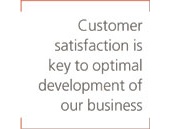 Abengoa
Abengoa
Annual Report 2012
- Corporate Social Responsibility
- People
- Customers
- Our customers’ satisfaction: a top priority
With the aim of achieving the full satisfaction of its customers, the company has mechanisms in place to measure and evaluate their level of satisfaction, take in suggestions and complaints, establish improvement plans and respond rapidly and effectively to any information requirements. Implementation and smooth functioning of these processes are reviewed and assessed both externally and internally through an annual program of monitoring and follow-up visits.
Given the diversity of its products and services, at Abengoa gauging customer satisfaction is performed in a decentralized manner in each one of the group companies.
- The instruments used for this purpose are the following:
- Satisfaction questionnaires or interviews.
- Questionnaires on internal perception of satisfaction.
- Periodic meetings.
- Addressing claims and complaints.
- Compiling and analyzing congratulation letters, signing coordinated quality agreements, and customer evaluations.
Periodicity in evaluating customer satisfaction depends on the product or service supplied:
- Products and services: periodically (on an annual basis or exceeding one year).
- Works execution: during project execution itself or upon completion.
Based on the results obtained through the assessment systems, specific performance plans and targets are established in order to meet the expectations of each customer typology and thereby increase their level of satisfaction.

In 2012, 253 TSRs (Troubleshooting Reports) were registered as the result of customer complaints, which entailed non-quality costs of 316,584 €.
Abengoa’s information channels recorded no fines in 2012 as the result of failure to comply with regulations pertaining to supply and use of products and services.
Nota 1: In the 2012, the percentage of customers included in the sample was 65 %, and 76 % of the responses were obtained.

© 2012 Abengoa. All rights reserved
